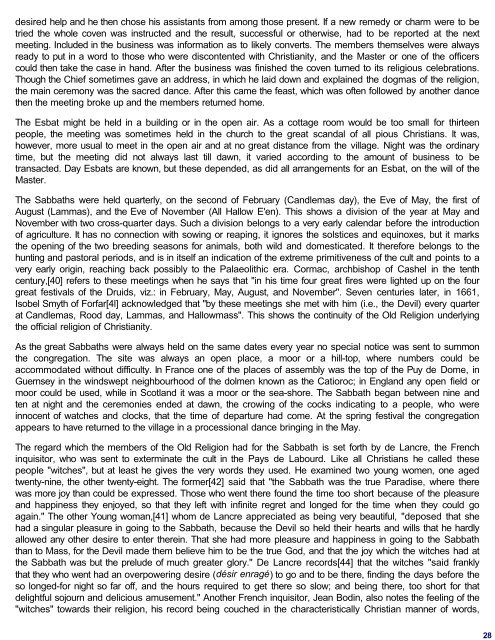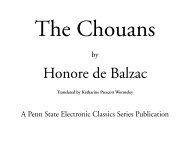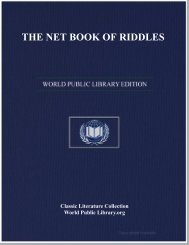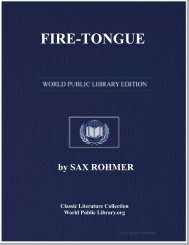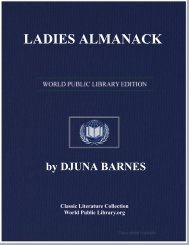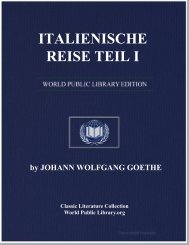THE GOD OF THE WITCHES - World eBook Library - World Public ...
THE GOD OF THE WITCHES - World eBook Library - World Public ...
THE GOD OF THE WITCHES - World eBook Library - World Public ...
You also want an ePaper? Increase the reach of your titles
YUMPU automatically turns print PDFs into web optimized ePapers that Google loves.
desired help and he then chose his assistants from among those present. If a new remedy or charm were to be<br />
tried the whole coven was instructed and the result, successful or otherwise, had to be reported at the next<br />
meeting. Included in the business was information as to likely converts. The members themselves were always<br />
ready to put in a word to those who were discontented with Christianity, and the Master or one of the officers<br />
could then take the case in hand. After the business was finished the coven turned to its religious celebrations.<br />
Though the Chief sometimes gave an address, in which he laid down and explained the dogmas of the religion,<br />
the main ceremony was the sacred dance. After this came the feast, which was often followed by another dance<br />
then the meeting broke up and the members returned home.<br />
The Esbat might be held in a building or in the open air. As a cottage room would be too small for thirteen<br />
people, the meeting was sometimes held in the church to the great scandal of all pious Christians. It was,<br />
however, more usual to meet in the open air and at no great distance from the village. Night was the ordinary<br />
time, but the meeting did not always last till dawn, it varied according to the amount of business to be<br />
transacted. Day Esbats are known, but these depended, as did all arrangements for an Esbat, on the will of the<br />
Master.<br />
The Sabbaths were held quarterly, on the second of February (Candlemas day), the Eve of May, the first of<br />
August (Lammas), and the Eve of November (All Hallow E'en). This shows a division of the year at May and<br />
November with two cross-quarter days. Such a division belongs to a very early calendar before the introduction<br />
of agriculture. It has no connection with sowing or reaping, it ignores the solstices and equinoxes, but it marks<br />
the opening of the two breeding seasons for animals, both wild and domesticated. It therefore belongs to the<br />
hunting and pastoral periods, and is in itself an indication of the extreme primitiveness of the cult and points to a<br />
very early origin, reaching back possibly to the Palaeolithic era. Cormac, archbishop of Cashel in the tenth<br />
century,[40] refers to these meetings when he says that "in his time four great fires were lighted up on the four<br />
great festivals of the Druids, viz.: in February, May, August, and November". Seven centuries later, in 1661,<br />
Isobel Smyth of Forfar[4l] acknowledged that "by these meetings she met with him (i.e., the Devil) every quarter<br />
at Candlemas, Rood day, Lammas, and Hallowmass". This shows the continuity of the Old Religion underlying<br />
the official religion of Christianity.<br />
As the great Sabbaths were always held on the same dates every year no special notice was sent to summon<br />
the congregation. The site was always an open place, a moor or a hill-top, where numbers could be<br />
accommodated without difficulty. In France one of the places of assembly was the top of the Puy de Dome, in<br />
Guernsey in the windswept neighbourhood of the dolmen known as the Catioroc; in England any open field or<br />
moor could be used, while in Scotland it was a moor or the sea-shore. The Sabbath began between nine and<br />
ten at night and the ceremonies ended at dawn, the crowing of the cocks indicating to a people, who were<br />
innocent of watches and clocks, that the time of departure had come. At the spring festival the congregation<br />
appears to have returned to the village in a processional dance bringing in the May.<br />
The regard which the members of the Old Religion had for the Sabbath is set forth by de Lancre, the French<br />
inquisitor, who was sent to exterminate the cult in the Pays de Labourd. Like all Christians he called these<br />
people "witches", but at least he gives the very words they used. He examined two young women, one aged<br />
twenty-nine, the other twenty-eight. The former[42] said that "the Sabbath was the true Paradise, where there<br />
was more joy than could be expressed. Those who went there found the time too short because of the pleasure<br />
and happiness they enjoyed, so that they left with infinite regret and longed for the time when they could go<br />
again." The other Young woman,[41] whom de Lancre appreciated as being very beautiful, "deposed that she<br />
had a singular pleasure in going to the Sabbath, because the Devil so held their hearts and wills that he hardly<br />
allowed any other desire to enter therein. That she had more pleasure and happiness in going to the Sabbath<br />
than to Mass, for the Devil made them believe him to be the true God, and that the joy which the witches had at<br />
the Sabbath was but the prelude of much greater glory." De Lancre records[44] that the witches "said frankly<br />
that they who went had an overpowering desire (désir enragé) to go and to be there, finding the days before the<br />
so longed-for night so far off, and the hours required to get there so slow; and being there, too short for that<br />
delightful sojourn and delicious amusement." Another French inquisitor, Jean Bodin, also notes the feeling of the<br />
"witches" towards their religion, his record being couched in the characteristically Christian manner of words,<br />
28


